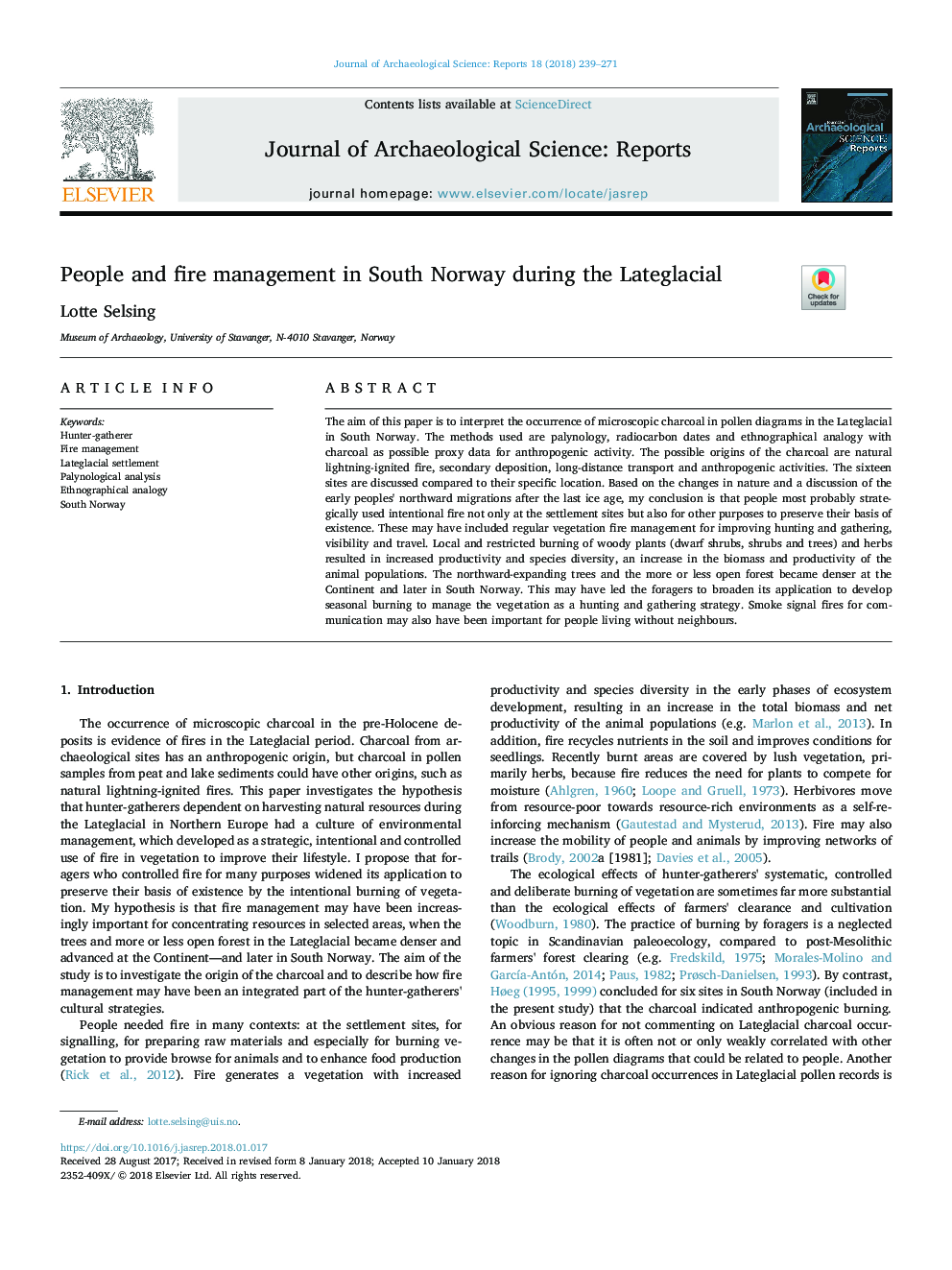| کد مقاله | کد نشریه | سال انتشار | مقاله انگلیسی | نسخه تمام متن |
|---|---|---|---|---|
| 7444853 | 1483925 | 2018 | 33 صفحه PDF | دانلود رایگان |
عنوان انگلیسی مقاله ISI
People and fire management in South Norway during the Lateglacial
ترجمه فارسی عنوان
مردم و مدیریت آتش سوزی در جنوب نروژ در دوران پس از زایمان
دانلود مقاله + سفارش ترجمه
دانلود مقاله ISI انگلیسی
رایگان برای ایرانیان
کلمات کلیدی
شکارچی جمع کننده، مدیریت آتش، حل و فصل گل سرخ، تجزیه و تحلیل پالینولوژیک، قیاسی قومی جنوب نروژ،
ترجمه چکیده
هدف از این مقاله، تفسیر وقوع زغال چوب میکروسکوپیک در نمودارهای گرده در گل سرخ در جنوب نروژ است. روش های مورد استفاده عبارتند از پالینولوژی، تاریخ رادیو کربن و قومی مشابه با زغال چوب به عنوان داده های پروکسی ممکن برای فعالیت های انسان شناسی. ریشه های احتمالی زغال چوب عبارتند از آتش سوزی طبیعی، آتش سوزی، رسوب ثانویه، حمل و نقل از راه دور و فعالیت های انسان شناسی. شانزده سایت در مقایسه با مکان خاص آنها مورد بحث قرار می گیرد. بر اساس تغییرات در طبیعت و بحث در مورد مهاجرت های شمال به شمال پس از آخرین عصر یخبندان، نتیجه گیری من این است که مردم احتمالا از لحاظ استراتژیک، آتش سوزی عمدی را نه تنها در محل های سکونت استفاده می کنند، بلکه همچنین برای اهداف دیگری برای حفظ موجودی خودشان . این ممکن است شامل مدیریت منظم پوشش گیاهی برای بهبود شکار و جمع آوری، دید و مسافرت باشد. سوختگی محلی و محدود گیاهان جنگلی (درختچه های کوتوله، درختچه ها و درختان) و گیاهان سبب افزایش بهره وری و تنوع گونه ها، افزایش زیست توده و بهره وری جمعیت حیوانات شد. درختان در حال گسترش به شمال و جنگل های بیشتر یا کمتر باز شد و در قاره و بعد در جنوب نروژ شد. این ممکن است منجر به کمک دهندگان به گسترش استفاده از آن برای توسعه سوزاندن فصلی برای مدیریت پوشش گیاهی به عنوان یک استراتژی شکار و جمع آوری. آتش سوزی سیگنال برای برقراری ارتباط نیز ممکن است برای افرادی که بدون همسایه زندگی می کنند، مهم باشد.
موضوعات مرتبط
علوم انسانی و اجتماعی
علوم انسانی و هنر
تاریخ
چکیده انگلیسی
The aim of this paper is to interpret the occurrence of microscopic charcoal in pollen diagrams in the Lateglacial in South Norway. The methods used are palynology, radiocarbon dates and ethnographical analogy with charcoal as possible proxy data for anthropogenic activity. The possible origins of the charcoal are natural lightning-ignited fire, secondary deposition, long-distance transport and anthropogenic activities. The sixteen sites are discussed compared to their specific location. Based on the changes in nature and a discussion of the early peoples' northward migrations after the last ice age, my conclusion is that people most probably strategically used intentional fire not only at the settlement sites but also for other purposes to preserve their basis of existence. These may have included regular vegetation fire management for improving hunting and gathering, visibility and travel. Local and restricted burning of woody plants (dwarf shrubs, shrubs and trees) and herbs resulted in increased productivity and species diversity, an increase in the biomass and productivity of the animal populations. The northward-expanding trees and the more or less open forest became denser at the Continent and later in South Norway. This may have led the foragers to broaden its application to develop seasonal burning to manage the vegetation as a hunting and gathering strategy. Smoke signal fires for communication may also have been important for people living without neighbours.
ناشر
Database: Elsevier - ScienceDirect (ساینس دایرکت)
Journal: Journal of Archaeological Science: Reports - Volume 18, April 2018, Pages 239-271
Journal: Journal of Archaeological Science: Reports - Volume 18, April 2018, Pages 239-271
نویسندگان
Lotte Selsing,
